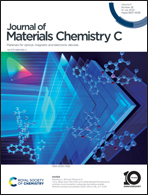Ultra-deep-blue thermally actrivated delayed fluorescence emitters constructed by carbazole derivatives enable efficient solution-processed OLED with a CIEy of < 0.05†
Abstract
Thermally activated delayed fluorescence (TADF) emitters that satisfy the blue gamut of the BT.2020 standard have rarely been reported, severely hindering the application of TADF in full-color ultra-high definition (UHD) displays. Herein, three solution-processable ultra-deep-blue TADF emitters, namely BFCz-TDBA, ICz-TDBA and PIdCz-TDBA, were cleverly designed and synthesized by linking a rigid and symmetric oxygen-bridged boron acceptor directly to carbazole derivative donors with different strengths. All these TADF emitters exhibited ultra-deep-blue photoluminescence below 430 nm with a narrow full-width-at-half-maximum of less than 50 nm. Furthermore, their favorable solubility and thermal stability make them suitable for solution processing. The resultant solution-processed ultra-deep-blue organic light-emitting diodes (OLEDs) based on all the emitters exhibited a maximum external quantum efficiency of 12.0%, 13.0% and 12.2% for BFCz-TDBA, ICz-TDBA and PIdCz-TDBA, respectively. Correspondingly, their related Commission Internationale de l’Eclairage (CIE) chromaticity coordinates were (0.16, 0.044), (0.16, 0.049) and (0.16, 0.046), respectively, which represent the state-of-the-art deep-blue emission among solution-processed devices (CIEy < 0.05). The typical BT.2020 blue gamut of these materials demonstrate their enormous potential for application in UHD displays.



 Please wait while we load your content...
Please wait while we load your content...